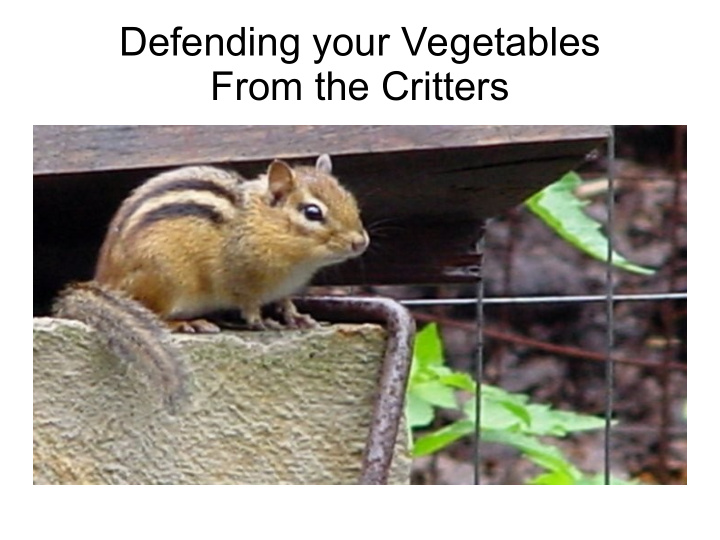



Defending your Vegetables From the Critters
When you buy a house... On a road like this...
You should expect this!
Strategies ● Change the habitat ● Get a pet that chases ● Install scare devices ● Plant things they don’t like ● Kill or trap the animal ● Make the area smell bad or taste nasty ● Put up a fence ● Not recommended: poison
How to choose? ● Expense – Immediate – Ongoing ● Effectiveness ● Convenience ● Safety ● Appearance
Strategy: distasteful plants Herbs ● Herbs need no protection from deer! ● Success with: basil, chives, lemon balm, mint, summer savory, oregano, sage and thyme ● Exception: parsley ● Onion family safe from deer Common Chives
Strategy: Population Control ● Hunting – Must follow hunting regulations ● licenses ● distance from dwellings ● Trapping – Kill traps – Capture traps
NYS Law ● Unprotected animals can be killed at any time – Chipmunks, voles, moles, red squirrels, & woodchucks ● Hunting & trapping for protected animals controlled by law – Rabbits, skunks, grey squirrels, & deer ● Exceptions made for animals causing extensive property damage – Permits required
Strategy: Trapping It is illegal for a home owner to transport live wild animals off one's property in NYS What are you going to do with it???
Evaluation: Population Control Advantages - Does not change the appearance of property Disadvantages – Restrictions – Animals quickly refill vacated space – Most of us can't or won't kill
Strategy: Smell & Taste Repellents Repellents are pesticides = controlled substances Must be used according to label directions Smell based repellents usually work better than taste based.
What is in a Repellent? ● Putrescent egg solids – highly effective - deer ● Capsaicin – highly effective against deer ● Garlic ● Cinnamon oil, clove oil ● Dried blood meal ● Ammonium soaps of higher fatty acids - medium ● Predator urine
Invest in a pump sprayer
Read the label before you buy! ● What plants can be sprayed? – Does it damage flowers? – It is OK for vegetables? Fruit? ● Are there times plants should not be sprayed? ● How often should plants be sprayed?
General directions for use ● Spray at or before the FIRST sign of damage – Before THEY get to know & love your plants ● Spray on regular schedule – every 4 weeks or as label directs – More often to cover new growth ● Allow 24 hours of dry weather after spraying ● Spray when temperatures between 40-80F
Effectiveness ● Best for small areas ● Best in summer – when deer have other foods ● Works best when fewer deer ● Works best when used with other techniques ● Alternating sprays may help
Why did the repellent stop working? ● Did not spray often enough – Deer must be able to smell repellent! ● Did not spray after heavy rains ● There was no other food around ● Remember: the deer never give up!!
Fence plus Repellent ● Combines visual barrier & odor repellent ● 3'-4' fence posts around perimeter ● Cotton cord or rope at 30” for deer and at 6” for woodchuck ● Tie strips of cotton cloth every 3' and dip ● OR use paint brush to paint repellent on rope
Fence plus Repellent Edible Landscape 9/24/2008
Evaluation: spray repellents Advantages – No change in the appearance of the garden – Lower initial expense for a small garden Disadvantages – Open windows? – Continual maintenance expense – Very expensive for large areas – Will suffer some damage – Many/most not recommended for vegetables
Gardener: Know thyself!
Strategy: Exclusion ● Fence the garden with wire fencing, netting or electric fencing
Deer Fence ● Permanent woven wire 8' high – lasts 20 years ● Polypropylene Netting – 6'-8' high ● Shorter fences work around smaller areas
Fences for Rabbits and Woodchucks ● 4' high hardware cloth with 1” mesh buried 12” deep or bent into L and buried 1-2” deep ● Plus electric wires at 2-6” above ground and 3” above top ● or ● Deer netting behind/above the hardware cloth
Poughkeepsie Farm Project 8' deer fence
Woven Wire
Every fence needs a gate... Locust Grove
Or a bigger gate...
The backup fence...
Polypropylene Netting ● Less visible than wire ● Inexpensive ● Less durable than wire ● Good as temporary solution ● Does not deter rabbits
N E T T I N G T Y P E S
Netting Installation
Electric Fences ● Temporary or permanent ● Fur is an insulator ● Deer must be trained to the fence – Peanut butter on foil hung from wire encourages nose to fence contact
Evaluation: Electric Fencing Advantages – Almost invisible – Cheaper than a permanent fence Disadvantages – Must keep vegetation clear under fence – Vulnerable to falling branches, etc. – Some animals learn to go through, under, or over Deer can slide under 2' wire
What's wrong with this fence?
Damage by leaping deer
Next Problem!
What's wrong with this fence?
Next problem! 2001
Why is Chuck still a problem? 2006
The Gardener! We don't do the things we know must be done to solve the problem.
Fence Finally Fixed! 2009 ● 1’ trench, lined with old wire fence & palisades
I hope! Super tall deer netting & 3’ chicken wire
Things that go bump in the night... 1:05am 8/31/2009
Coping with Chipmunks
Protecting Squash Seeds Leave some air circulation
Protecting Bush Beans
Sacrificial Tomatoes
Sometimes there is no defense!
Links ● www.gardening.cornell.edu search on deer ● www.gardening.cornell.edu/factsheets/deerdef/ index.html ● wildlifecontrol.info/ – Links section contains fact sheets for control of several animals ● Library catalog search Subject “Deer – Control” ● “The $64 Tomato” by William Alexander – for information on electric fences
A special thanks to: ● My husband, Ed Nisley, for many of the photos ● Several Master Gardeners for sharing information ● The horticulturists at the Locust Grove Estate
Recommend
More recommend